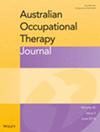‘I couldn't change his nappy’: New mothers' experiences of De Quervain's tendinosis and its impact on occupational performance
Abstract
Introduction
De Quervain's stenosing tendinosis (DQST) is common in new mothers because of awkward wrist postures during repetitive mothering occupations such as nursing and lifting their baby. However, little is known about how DQST affects occupations of first-time mothers. This study aimed to explore the experiences of first-time mothers living with DQST and how it affects performance of their motherhood occupations.
Methods
A descriptive phenomenological study design was used. Participants were 15 first-time mothers of a child aged ≤24 months, with a current or previous diagnosis of DQST, and/or non-trauma-related symptoms of pain, tenderness, and/or swelling near the base of the thumb or wrist. Participants completed the Disabilities of the Arm, Shoulder, and Hand (DASH) questionnaire and participated in semi-structured interviews.
Consumer and Community Involvement
No consumer and community involvement.
Findings
Five themes developed from interview data: (1) My everyday life is affected; (2) not being prepared and not knowing what to do; (3) learning to modify, adapt, and carry on; (4) perceived practicality of management options; and (5) the importance of education and early intervention. DASH disability scores ranged from 50 to 80 for participants with active symptoms.
Conclusion
DQST disrupted first-time mothers' occupational performance. Participants felt that until they developed DQST, they received insufficient information about it from health professionals during pregnancy and the first-year post-birth. Pain management options were often not practical when performing motherhood occupations. New mothers would benefit from preventative perinatal education about DQST and treatment options that consider their mothering occupations.
PLAIN LANGUAGE SUMMARY
New mothers can develop a common upper limb condition called De Quervain's Stenosing Tendinosis (DQST), also known as ‘mummy's thumb’, which can make daily occupations difficult. This includes bathing, dressing, and helping their babies sleep. Fifteen first-time mothers with babies under 2 years old and DQST were interviewed and filled out a functional questionnaire. The results showed that DQST affected their daily occupations, such as caring for their babies, doing housework, self-care, leisure occupations, sleep, social interactions, and self-esteem. Many mothers said they did not receive any information about DQST before they developed it during pregnancy or in their baby's first year. Some were given treatment options like using a splint to rest their hand, but these were not always comfortable or practical due to their caregiving duties. The study highlighted that educating mothers on how to adjust their occupations during pregnancy and after birth could help prevent DQST. Treatment options should also consider their role as caregivers. This was the first study to look at how a common hand condition affects mothers' daily occupations. A limitation was that the study did not ask mothers for details about their marital status, culture, or economic background, which could have added to the understanding of the group's diversity.

 求助内容:
求助内容: 应助结果提醒方式:
应助结果提醒方式:


